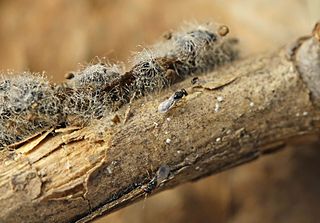
Casuarina, also known as she-oak, Australian pine and native pine, is a genus of flowering plants in the family Casuarinaceae, and is native to Australia, the Indian subcontinent, Southeast Asia, islands of the western Pacific Ocean, and eastern Africa.

The Eulophidae is a large family of hymenopteran insects, with over 4,300 described species in some 300 genera. The family includes the genus Elasmus, which used to be treated as a separate family, "Elasmidae", and is now treated as a subfamily of Eulophidae. These minute insects are challenging to study, as they deteriorate rapidly after death unless extreme care is taken, making identification of most museum specimens difficult. The larvae of very few species feed on plants, but the majority are primary parasitoids on a huge range of arthropods at all stages of development. They are exceptional in that they are one of two hymenopteran families with some species that are known to parasitize thrips. Eulophids are found throughout the world in virtually all habitats.
Afrotroppopsis is a monotypic genus of hymenopteran insects of the family Eulophidae.
Agmostigma is a small genus of hymenopteran insects of the family Eulophidae which contains three species, all described in 1996 by Ubaidillah and LaSalle and so far only recorded from Brunei in northern Borneo.
Anaprostocetus is a genus of hymenopteran insects of the family Eulophidae.
Aprostoporoides is a small Indomalayan genus of hymenopteran insects of the family Eulophidae which was described in 2004 with two newly described species from Kerala.
Asecodes is a genus of hymenopteran insects of the family Eulophidae. They are endoparasitoids of Galerucella larvae.
Baeoentedon is a genus of hymenopteran insects of the family Eulophidae, they are parasitoids of whitefly from the family Aleyrodidae which are found on trees of the genus Ficus. They have been recorded from Australia, China, India, Indonesia and Florida. A fifth species, Baeoentodon farazi, was described from Karnataka, India, in 2017.

Colpoclypeus is a genus of hymenopteran insects of the family Eulophidae.
Emersonella is a genus of hymenopteran insects of the family Eulophidae. Several species are known to be phoretic parasitoids of female tortoise beetles, laying their eggs in the eggs of the beetle host.
Eprhopalotus is a genus of hymenopteran insects of the family Eulophidae. Their distribution varies between species but ranges from Costa Rica, Mexico to Texas. There are currently 5 species of Eprhopalotus:

Euplectrus is a genus of hymenopteran insects of the family Eulophidae.

Galeopsomyia is a New World genus of hymenopteran insects of the family Eulophidae. The genus is a hyperparasitoid of other gall-inducing wasps of the genera Eurytoma and Torymus.
Goetheana is a genus of hymenopteran insects of the family Eulophidae. As a parasitoid of thrips, this wasp is used in biological pest control.

Horismenus is a genus of hymenopteran insects of the family Eulophidae occurring primarily in the Americas. As of 2015 over 400 species in the genus have been described. Horismenus species are often described as parasitizing other insects.
Kolopterna is a genus of hymenopteran insects of the family Eulophidae. Kolopterna comprises 14–15 species distributed in the Palearctic and Oriental regions All Kolopterna species are endoparasitoids of gall midges causing galls on various Chenopodiaceae.

Leptocybe invasa, the blue gum chalcid wasp or eucalyptus gall wasp, is a chalcid wasp which is the only species in the monotypic genus Leptocybe in the subfamily Tetrastichinae, of the family Eulophidae. It is a gall wasp which causes the formation of galls on a number of species of Eucalyptus, it was described in 2004 after galls were found in river red gums in the Mediterranean and Middle East and has since been found to be a widespread species where its host trees are planted. It is indigenous to Australia.

Minotetrastichus is a genus of hymenopteran insects of the family Eulophidae. They are parasites of leaf-mining Lepidoptera, Coleoptera, and Hymenoptera.
Notanisomorphella is a genus of hymenopteran insects of the family Eulophidae. They are parasitoids with hosts including Coleophoridae, leaf mining beetles, and spider eggs.
Dentalion is a genus of Neotropical hymenopteran insects of the family Eulophidae.






